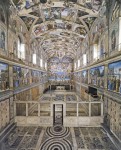 The Vatican debuted a cutting edge new LED lighting system in the Sistine Chapel on Wednesday. Designed and installed by the German company Osram, the new system features more than 7,000 light-emitting diodes mounted behind a cornice high up on the walls. It’s energy efficient, requiring up to 90% less electricity than the 1980s halogen lighting system it replaced while providing five to ten times more brightness.
The Vatican debuted a cutting edge new LED lighting system in the Sistine Chapel on Wednesday. Designed and installed by the German company Osram, the new system features more than 7,000 light-emitting diodes mounted behind a cornice high up on the walls. It’s energy efficient, requiring up to 90% less electricity than the 1980s halogen lighting system it replaced while providing five to ten times more brightness.
 Using a full complement of red, green, blue, warm white and cool white LED lights, the new system illuminates the complete color spectrum of the frescoes. It took four years of careful analysis by lighting designers, restorers and colorimetry experts to ensure the LEDs were set to properly light the original colors without altering their hue. They analyzed 280 points of the fresco pigments using a non-invasive system that illuminates the points with a calibrated light and measures the reflected spectrum. This highly accurate data served as the benchmark for the adjustments to the LED lights.
Using a full complement of red, green, blue, warm white and cool white LED lights, the new system illuminates the complete color spectrum of the frescoes. It took four years of careful analysis by lighting designers, restorers and colorimetry experts to ensure the LEDs were set to properly light the original colors without altering their hue. They analyzed 280 points of the fresco pigments using a non-invasive system that illuminates the points with a calibrated light and measures the reflected spectrum. This highly accurate data served as the benchmark for the adjustments to the LED lights.
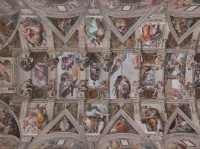 This is a huge change, beneficial to visitors and the long-term stability of the frescoes. The old system had eight 150 watt spotlights and two 1,000 watt projectors installed outside the chapel windows. They were big and hot, but because the windows were covered with semi-transparent plastic to protect the frescoes from damaging UV radiation, much of their light was absorbed before it made indoors. The end result was a perpetual low-contrast twilight which made the art harder to see and cast shadows on the works that were not spotlit. In a lesser chamber, this might not be much of a loss, but the works on the side walls of the chapel were painted by the likes of Botticelli, Ghirlandaio and Perugino.
This is a huge change, beneficial to visitors and the long-term stability of the frescoes. The old system had eight 150 watt spotlights and two 1,000 watt projectors installed outside the chapel windows. They were big and hot, but because the windows were covered with semi-transparent plastic to protect the frescoes from damaging UV radiation, much of their light was absorbed before it made indoors. The end result was a perpetual low-contrast twilight which made the art harder to see and cast shadows on the works that were not spotlit. In a lesser chamber, this might not be much of a loss, but the works on the side walls of the chapel were painted by the likes of Botticelli, Ghirlandaio and Perugino.
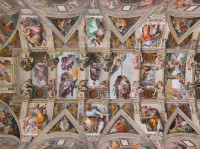 The new LEDs and accompanying reflectors ensure that not only are Michelangelo’s immortal ceiling and Last Judgment now lit with a homogeneous, visually accurate and glare-free light, but all of the art of the Sistine Chapel is illuminated to its greatest advantage. The end result is exceptionally vivid color, brightness, readability and boosted optical effects from the foreshortening technique Michelangelo used. The impression conveyed is one of enhanced three dimensionality.
The new LEDs and accompanying reflectors ensure that not only are Michelangelo’s immortal ceiling and Last Judgment now lit with a homogeneous, visually accurate and glare-free light, but all of the art of the Sistine Chapel is illuminated to its greatest advantage. The end result is exceptionally vivid color, brightness, readability and boosted optical effects from the foreshortening technique Michelangelo used. The impression conveyed is one of enhanced three dimensionality.
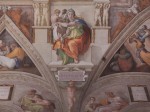 Preserving the paintings and improving the visitor experience were priorities in the installation of a new climate control system as well. When the old system was installed in the early 1990s, the Sistine Chapel was visited by fewer than two million people a year. That number has more than tripled since then, and six million sweating, breathing, stinking, dirt-tracking humans do a number on the environment in a closed space. The new air conditioning and filtration system, designed by Carrier, a part of United Technologies Corp., the same company that designed the first air conditioning system in 1993.
Preserving the paintings and improving the visitor experience were priorities in the installation of a new climate control system as well. When the old system was installed in the early 1990s, the Sistine Chapel was visited by fewer than two million people a year. That number has more than tripled since then, and six million sweating, breathing, stinking, dirt-tracking humans do a number on the environment in a closed space. The new air conditioning and filtration system, designed by Carrier, a part of United Technologies Corp., the same company that designed the first air conditioning system in 1993.
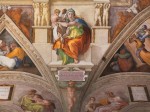 For two years engineers studied the climate inside the chapel, using the latest and greatest simulation tools to understand the movement of air, moisture and particulate matter in the space. I love this quote from Jackie Anderson, Senior Engineer at UTC: “Thinking about the Sistine Chapel and the air within it, it’s probably some of the most interesting air I will ever deal with.” Analysis of the issues required huge computational resources and resolving them took a great deal of ingenuity, especially since the final system had to be “church quiet,” nearly invisible and utilize pre-existing ductwork since obviously this is a historic building and you can’t just drill holes in it wherever.
For two years engineers studied the climate inside the chapel, using the latest and greatest simulation tools to understand the movement of air, moisture and particulate matter in the space. I love this quote from Jackie Anderson, Senior Engineer at UTC: “Thinking about the Sistine Chapel and the air within it, it’s probably some of the most interesting air I will ever deal with.” Analysis of the issues required huge computational resources and resolving them took a great deal of ingenuity, especially since the final system had to be “church quiet,” nearly invisible and utilize pre-existing ductwork since obviously this is a historic building and you can’t just drill holes in it wherever.
There was a lot on the line. If the temperature, humidity, dust and pollutants could not be controlled, then the Vatican was going to have to take drastic action to preserve the paintings, ie, close the chapel to tourists, something it definitely did not want to do. Carbon dioxide levels were a most pressing concern. In 2010, curators found areas of the paint were developing a crusty white patina. Analysis of the white powder found it was composed of calcium carbonate and calcium bicarbonate deposits, probably formed when rising carbon dioxide levels and humidity moved through the plaster walls of the chapel. The white patches were removed easily with no damage to the paint, but the situation was a big red flag that the old systems were no longer able to control the elements.
The new air conditioning system has three times greater cooling capacity, twice as energy efficient, six filtration levels and 70 different sensors to monitor the numbers of visitors and the air quality. The room will remain perpetually at 77 degrees Fahrenheit or lower, with temperatures, ventilation and humidity levels adjusted according to the number of people in the chapel. The system taps into three security cameras to actually count the bodies in the room at any given time and then governs itself accordingly. It can be monitored from a computer, tablet or a smartphone.
The total cost of both lighting and climate control systems is estimated to be around $3.8 million. The companies donated their services, plus there was additional funding support from the EU.
This video lingers on the frescoes under the new lighting system:
[youtube=http://youtu.be/tvLv7T_PrOA&w=430]
Here’s a Carrier video about the new air system. There isn’t much detail about the technology, sadly, but there is that quote from Jackie Anderson and several cool glimpses of the simulations.
[youtube=http://youtu.be/wfFppqDDeRU&w=430]